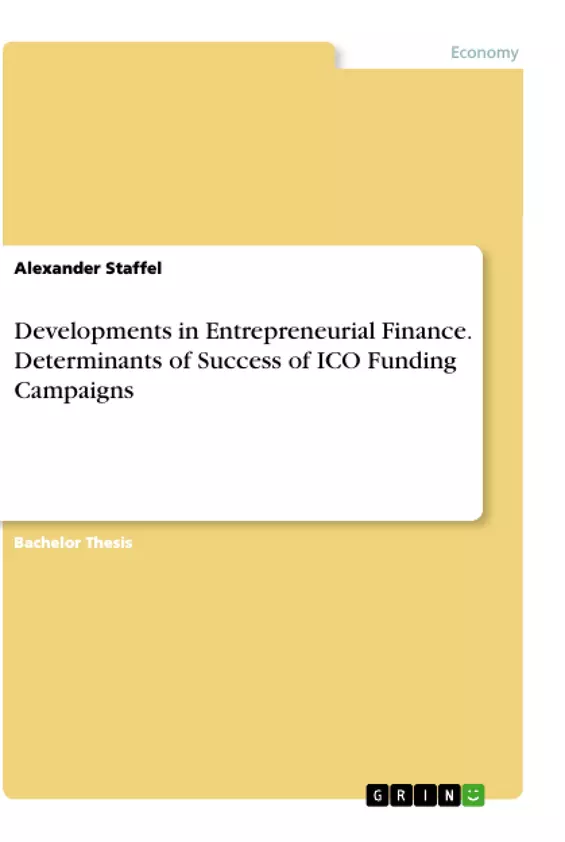The aim of this paper is to identify the determinants of success of ICO funding campaigns. Success is measured by the three proxy metrics funding, listing and survival success. By conducting an empirical analysis of a dataset containing information of 260 ICOs which took place between October 2017 and June 2019, a logit regression model is applied. The results should add to the already existing and constantly growing but still only sparse literature and research about what makes ICOs successful. The findings should point out which characteristics of ICOs are crucial for achieving success and are highly relevant for businesses, managers and start-ups, wishing to make use of initial token sales for funding purposes.
Inhaltsverzeichnis (Table of Contents)
- Introduction
- Blockchain, cryptocurrencies and Initial Coin Offerings (ICOs)
- Blockchain
- Cryptocurrencies
- Initial Coin Offerings (ICOs)
- Literature review
- Methodology and research hypotheses
- Methodology
- Research hypotheses
- Empirical analysis
- Dataset and descriptive statistics
- Determinants of success
- Limitations and future research
- Conclusions
Zielsetzung und Themenschwerpunkte (Objectives and Key Themes)
This paper aims to identify the determinants of success for Initial Coin Offering (ICO) funding campaigns. The author measures success using three proxy metrics: funding success, listing success, and survival success. The analysis focuses on the characteristics of ICOs that contribute to achieving these success metrics, providing insights for businesses and startups considering ICOs as a funding option.
- Understanding the concept of ICOs and their relationship to blockchain technology and cryptocurrencies.
- Analyzing the determinants of success in ICO funding campaigns.
- Exploring the impact of various factors on funding, listing, and survival success.
- Contributing to the understanding of post-ICO performance and its influencing factors.
- Developing insights into the role of blockchain technology and ICOs in the financial landscape.
Zusammenfassung der Kapitel (Chapter Summaries)
- Introduction: The paper introduces the concept of ICOs as a new form of financing enabled by blockchain technology. It discusses the similarities and differences of ICOs to other financing sources and highlights the importance of understanding the factors influencing their success.
- Blockchain, cryptocurrencies and Initial Coin Offerings (ICOs): This chapter provides a foundational understanding of blockchain technology, cryptocurrencies, and ICOs. It explores their technical details and significance within the financial landscape.
- Literature review: This chapter presents an overview of existing research on ICOs, focusing on studies that identify factors influencing their outcomes. It provides a contextual understanding of the existing knowledge about the topic.
- Methodology and research hypotheses: This chapter explains the methodology employed for data collection, processing, and analysis. It outlines the specific research hypotheses formulated based on the literature review and the research objectives.
- Empirical analysis: This chapter presents the results of the empirical analysis conducted on a dataset containing information about 260 ICOs. It includes a description of the dataset, its descriptive statistics, and a discussion of the regression analysis findings. This chapter explores the relationship between various characteristics of ICOs and their success metrics.
Schlüsselwörter (Keywords)
The key terms and focus topics of this paper include Initial Coin Offerings (ICOs), blockchain technology, cryptocurrencies, funding success, listing success, survival success, empirical analysis, logit regression model, and determinants of success.
- Quote paper
- Alexander Staffel (Author), 2020, Developments in Entrepreneurial Finance. Determinants of Success of ICO Funding Campaigns, Munich, GRIN Verlag, https://www.grin.com/document/1191497



